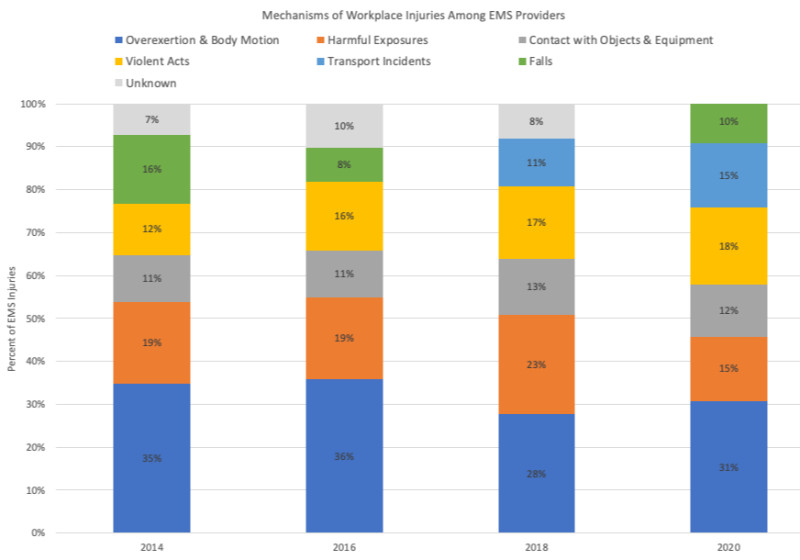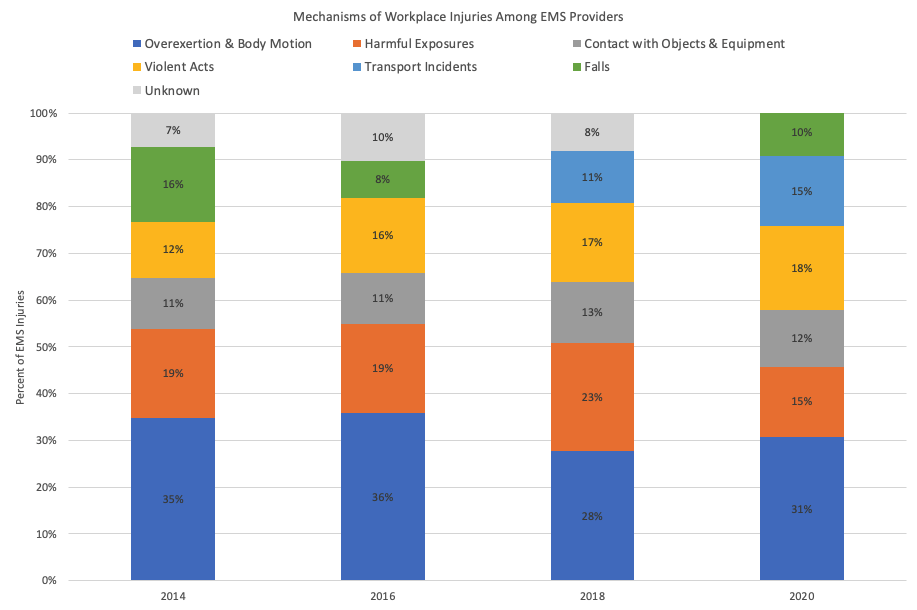
Emergency Medical Service (EMS) workers provide pre-hospital care to patients in diverse and often complex situations. Frequent interactions with sick individuals, dynamic emergency scenes, and rapid transportation pose an inherent risk to the physical and psychological safety of EMS providers. In 2020, approximately 16,9000 EMS workers received emergency department care for a workplace injury.1
Although a workplace injury can happen to anyone in the EMS field, the distribution of injuries is not even across demographic groups. A recent systematic review that looked at occupational injuries among paramedics found that the injury rate is disproportionally high in female providers.2 Approximately 40% of injuries occurred in females, despite them only making up about a third of the workforce.1,3 Females were specifically found to have higher rates of violence and transport-related injuries.2
In 2020, 57% of injuries occurred in EMS providers under the age of 34, with 41% occurring in employees between the ages of 25 and 34.1 In addition to patient-dependent factors such as age and sex, research has found that EMS injuries are also associated with experience and agency type. Multiple studies have found that providers in their early career are at increased risk of injury, with one study in particular finding that 52% of transport injuries occurred among paramedics with less than five years of experience.2,4 The private sector is associated with an increased risk of injury compared to the public-governmental sector.2
Since 2008, overexertion and bodily motion have been identified as the most common mechanisms of injury for EMS providers (Figure 1).1 In 2020, 35% of injuries were caused by overexertion or body motion. Overexertion and body motion injuries can manifest from excessive physical effort, overuse or repetitive movements, and improper ergonomic positions. Sprains and strains are the most commonly diagnosed injuries in EMS providers. Of the 4,000 sprains/strains diagnosed in 2020, 44% occurred in the trunk, neck, or shoulders, and 56% resulted from over-exertion and bodily reactions.1
The second most common type of occupational injury reported among EMS workers was harmful exposure. According to NIOSH, harmful exposures are defined as exposure to dangerous environments/objects (excessively cold/hot, electrical currents, or toxic elements). In addition, harmful exposures include infectious agents and allergenic substances. In the mid-2000s, there was a marked increase in injuries from violent acts from previous years. Unfortunately, this trend has persisted, and in 2020, 18% of EMS workplace injuries could be attributed to violent acts.1 Given the burden of occupational injuries in the EMS workforce, it is imperative that individual providers and their employers take steps to reduce the occurrence of these often preventable injuries.

- 1. Centers for Disease Control and Prevention. Emergency Medical Service Workers. (August 18, 2022). Centers for Disease Control and Prevention. Retrieved January 25th, 2024 from https://www.cdc.gov/niosh/topics/ems/data.html. https://www.cdc.gov/niosh/topics/ems/data.html.
- 2. Kearney, J., Muir, C., & Smith, K. (2022). Occupational injury among paramedics: a systematic review. Injury prevention : journal of the International Society for Child and Adolescent Injury Prevention, 28(2), 175–184. https://doi.org/10.1136/injuryprev-2021-044405 https://doi.org/10.1136/injuryprev-2021-044405
- 3. Cash, R. E., Powell, J. R., Peters, G. A., Goldberg, S. A., Panchal, A. R., & Camargo, C. A., Jr (2022). Trends in demographic and employment characteristics of US emergency medical technicians and paramedics, 2011-2019. Journal of the American College of Emergency Physicians open, 3(4), e12776. https://doi.org/10.1002/emp2.12776 https://doi.org/10.1002/emp2.12776
- 4. U.S Fire Administration. Emergency Services Ergonomics and Wellness. U.S Fire Administration. Retrieved January 25th, 2024 from https://www.usfa.fema.gov/a-z/health-safety-wellness/ergonomics/ch1-emt-injuries.html https://www.usfa.fema.gov/a-z/health-safety-wellness/ergonomics/ch1-emt-injuries.html
- Dozens of courses and topics
- State-specific requirements
- We report to CAPCE in real time


